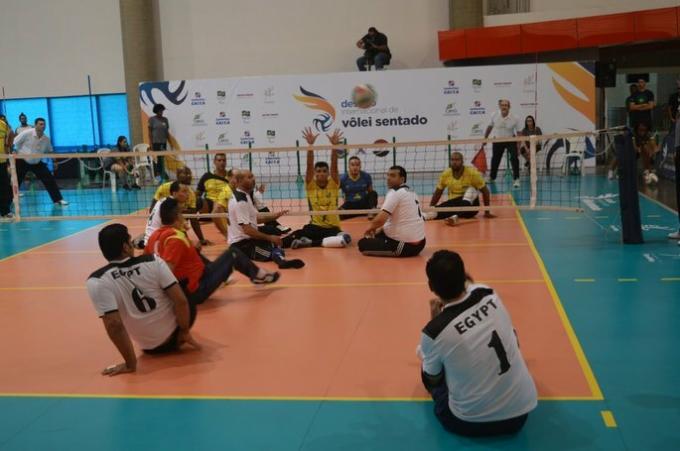Sitting volleyball is a sport modality that was adapted for people who have some kind of physical disability related to locomotion.
However, it can also be practiced by everyone, including physical education classes in schools.
This is because sitting volleyball improves physical health, reflexes, agility and motor coordination. In addition, it is a very fun sport that helps reduce anxiety and muscle pain.
Official Rules of Sitting Volleyball
- the playing area is the court space, which measures 10 x 6 meters, and the free zone, which must be at least 3 meters wide on all sides;
- the height of the net is 1.15 for men and 1.05 for women;
- there are two teams with 12 players each, with 6 in reserve and 6 on court;
- players can have the functions: attack, defense or libero (who is at the back of the court, being a specialist in defense);
- the game comprises 5 sets of 25 running points each and the team that wins 3 sets wins;
- if there is a tie of sets (2x2), the last set, called tie-break, will be decisive. Unlike other sets, points go up to 15.
- players cannot hit the ball without being in contact with the ground;
- each team can only touch the ball three times before passing it to the opposing team;
- points are scored when the ball touches the opponent team's court floor;
- Unlike traditional volleyball, in seated volleyball, the serve can be blocked by front-line players.
Seated volleyball court lines and areas
Very similar to traditional volleyball, in this modality there are lines and zones. All lines on the court must be light in color and 5 cm wide.
- boundary lines: 4 lines delimiting the playing court (two side lines and two end lines).
- centerline: Divides the court into two spaces of 5 and 6 meters.
- line of attack: they are 2 meters from the center of the field and mark the front area.
- front zone: near the net, it is bounded by the center line and the line of attack.
- loot zone: place where the withdrawal takes place. It is 6 meters wide and extends to the end of the free zone.
Seated Volleyball Classification
Depending on the severity of the disability and limitations, seated volleyball players are classified into two groups:
- severe disability (VS1): have more pronounced impairments related to locomotion, for example, amputated legs or arms.
- mild disability (VS2): have almost imperceptible deficiencies, for example, small limb amputations.
In addition to these two more general classifications, there is a functional classification divided into: amputees and les autres (the others, in French). Les autres are those who have some type of motor disability.
As for amputees, there is a classification that better specifies the disability:
- AK (above knee): amputation performed above or through the knee joint.
- BK (below knee): amputation performed below the knee, through or above the talus-heel joint, at the ankle.
- AE (above elbow): amputation performed above or through the elbow joint.
- BE (below elbow): amputation performed below the elbow, either across or above the wrist joint.
Therefore, through this classification, they are divided into 9 types:
- Class A1: double AK
- Class A2: simple AK
- Class A3: double BK
- Class A4: simple BK
- Class A5: double AE
- Class A6: simple AE
- Class A7: double BE
- Class A8: BE simple
- Class A9: combined lower and upper limb amputations
When did sitting volleyball appear?
This modality appeared in 1956 in the city of Arnhem, Holland.
It was created by combining traditional volleyball and a German game called sitzbal, which is also played sitting down, but instead of a net that divides the court, there is a ribbon.
When it was created, this modality was practiced only by men, but with time women began to participate as well.
Volleyball sitting at the Olympic Games
It was in 1976 in Toronto, Canada, that seated volleyball was introduced as a Paralympic sport and remains in the Olympic Games to this day.

Among all the Paralympic sports, it is considered one of the games with the greatest agility and speed and is currently played in more than 50 countries.
Volleyball sitting in Brazil
In Brazil, sitting volleyball began to be played in 2002. The following year, the Brazilian Volleyball Confederation for the Disabled (CBVD) was founded and, in that same year, the men's team participated in the Parapan-American games and won the silver medal.

Currently, the men's team has 3 gold medals in the Parapan-American Games (2007, Rio de Janeiro; 2011, Guadalajara; 2015, Toronto). In the 2014 world championship, the team won the silver medal.
Likewise, the women's team participated in the 2003 Parapan American Games and won the silver medal. In 2015 he also won silver at the Parapan American Games in Toronto.
In the 2016 Paralympic Games, in Rio de Janeiro, the women's team won the bronze medal.
Read more about this sport at:
- Volleyball: rules, fundamentals and history of volleyball
- Volleyball Fundamentals
- Volleyball court
- Volleyball history
- History of volleyball in Brazil
Bibliographic references
Brazilian Volleyball Confederation for the Disabled - CBVD
Brazilian Paralympic Committee - CPB
Ministry of Sports (ME) - Brazil

